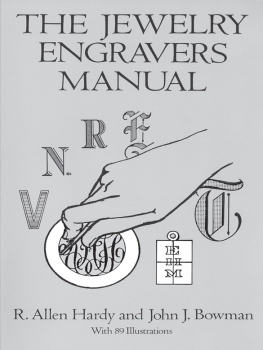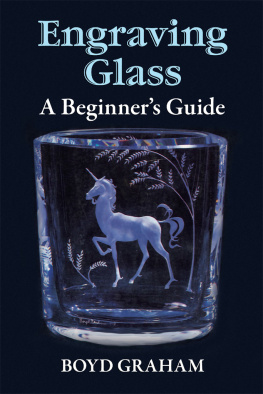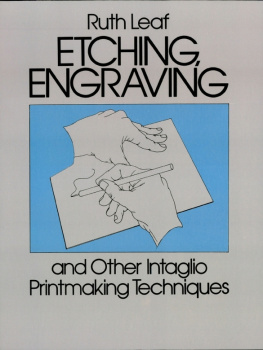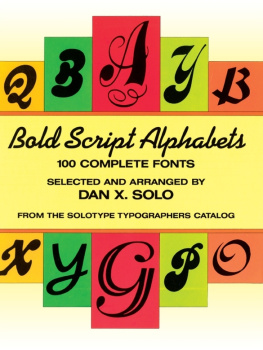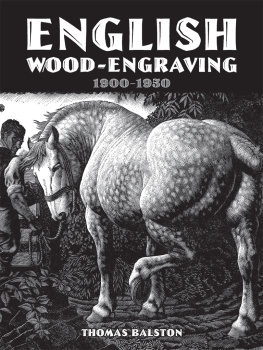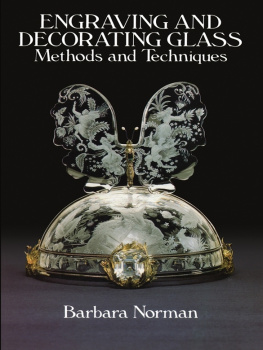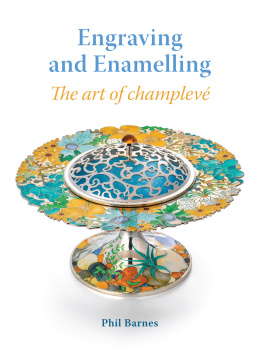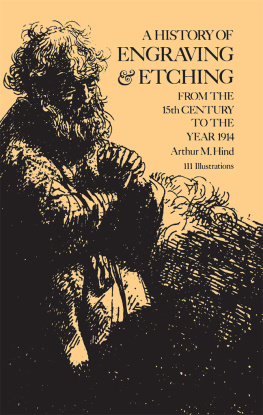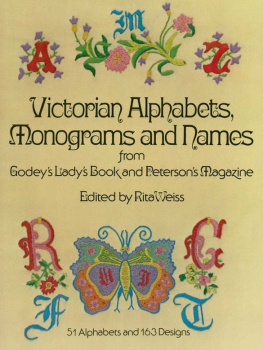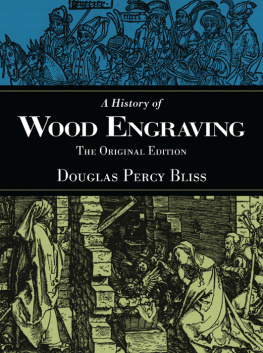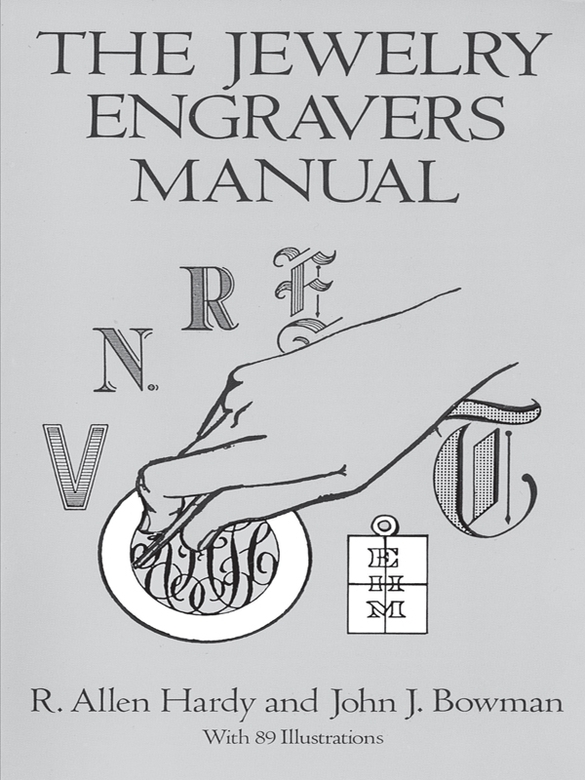Most of the following questions and answers deal with engraving problems. However, it is advantageous for the engraver to have knowledge of certain facts concerning jewelry work; so, the questions are chosen to cover all that we feel the engraver should know.
- What cleaning agents are generally used in connection with jewelry?
Soap, ammonia, cyanide and water solution, and soda.
- Which one would you use to remove tarnish?
Cyanide.
- Which one would you use to brighten the appearance of the article?
Soda.
- Which one would you use to remove dirt or greasy film?
Ammonia.
- What is used to remove scale formed in hard soldering?
A pickle solution composed of sulphuric acid and water. In a heated solution the proportions should be nine parts water and one part sulphuric acid. In cold solution the proportions should be eight parts water and two parts sulphuric acid. The work is plunged into the pickle while still hot from soldering.
- Is tripoli a cutting or polishing agent?
Cutting, because the abrasive grains are coarse.
- Is rouge a cutting or polishing agent?
Polishing, because the grain is very fine.
- Are the same buffs used for both?
No.
- What combination of ingredients make a good cleansing solution for removing tripoli, rouge, and generally cleaning the article?
Soap, soda, and ammonia with water.
- Will cyanide remove rouge or dirt?
No.
- What should be done about scratches or marred surfaces existing on an article, before engraving?
In some instances, the engraving may completely cover and obliterate an imperfection. If not possible to do this, it is wise to call the customers attention to the blemish to establish the fact that it occurred prior to engraving. If the article is a sale of your store and the customer has not discovered it, a slight scratch may be removed by careful burnishing and buffing. It is always advisable to acquaint the salesman or the customer (as the case may be) with the condition of the article in question.
- Suppose you made a slight slip of your graver on a line-finished compact and were able to burnish it out successfully, what would you use to restore the line finish over the burnished spot?
Emery paper.
- Suppose you made a slight slip on a satin-finished piece of sterling and burnished it successfully, what would you use to restore the satin finish?
Rub lightly with a common ink eraser.
- Suppose you slipped on a mirror-finished piece of sterling or gold and burnished successfully, what would you use to restore the mirror-finish?
A soft buff with rouge.
- Suppose you slipped on a lacquered brass plate or compact, what would you do?
Remove lacquer with denatured alcohol, burnish, refinish, and relacquer.
- Suppose you slipped on a piece of sterling and could not burnish; would you grind it off with a tripoli buff on polishing motor, and re-engrave?
Yes.
- Suppose you slipped on a gold-plated article and could not burnish, would you give it the same treatment?
No. The plating would be removed and the article ruined.
- Suppose you slipped on a gold-filled article and could not burnish ; would you grind it off and re-engrave?
No; this would ruin the article, if cheap grade. Yes; if of high-grade filled stock with thick outer layer of gold.
- Suppose you slipped on a silver-plated article; would you grind it off and re-engrave?
No. The article would be spoiled.
- Suppose you slipped on a solid gold article and could not burnish; would you grind it off and re-engrave?
Yes.
- Name eight metals on which you will probably have to engrave.
Aluminum, silver, copper, brass, platinum, gold, palladium and steel.
- How does aluminum cut?
Very soft, cuts flaky and gritty.
- How does silver cut?
Soft and smooth.
- How does copper cut?
Medium and smooth.
- How does nickel cut?
Fairly smooth, slightly gritty, tougher than copper.
- How does gold cut?
Hard according to karat (the lower the karat, the harder); usually smooth.
- How does brass cut?
Hard and tough.
- How does steel cut?
Always too hard for good cutting. Some is less brittle, if well annealed.
- How does palladium cut?
Not very smooth or bright.
- How does platinum cut?
Smoother than palladium, not bright.
- On cigarette lighters, what base metal is generally used? What plating?
Brass base; chrome, silver or gold plate.
- On an average ladys compact, what metals are generally used?
Brass and sterling.
- Are loving cups generally white or yellow?
Mostly white. A few are yellow.
- Are they generally plated or solid?
Plated.
- If plated in white metal, is lead or aluminum apt to be the base?
Lead alloy, or Britannia metal; soft metal.
- If gold plated, what is the base usually?
Brass or nickel-silver; may be marked E.P.N.S. (electro-plated nickel-silver) ; hard metal.
- Would you wriggle or bright cut a lead base?
Bright cut is better.
- Would you wriggle or bright cut a brass base?
Wriggle.
- Your graver slips; what is the probable trouble?
Rounded point. Broken belly line.
- Your graver cuts rough. Why?
It is either picking up metal or it has a rough cutting edge.
- What causes a graver to pick up metal on the right side of the belly?
A graver just sharpened sometimes picks up metal as it makes its first two of three cuts. After making a few practice cuts, the problem usually disappears. A dragging belly caused by incorrect lift will cause a pick-up of metal.
- Your graver cuts too deep. Why?
Face angle is too blunt or the tool has an inverted V belly.
- Your graver leaves a trail. Why?
A trail is a mark caused by the belly dragging at the very beginning of a cut. This is caused by an incorrect lift. An extremely low belly angle will cause the belly to leave a line or trail just as the point enters the metal. An extremely high lift or greatly increased belly angle may cause a similar result if the graver is too long. It is well to note that a high lift is more satisfactorily controlled when the graver is short.
- You cannot get a bright cut. Why?
Graver is not polished enough.
- Your graver wont hold a point. Why?
Too soft. It should be re-hardened and tempered.
- Your graver breaks points. Why?
The face angle may be more than 45 degrees which weakens the point. It could be too hard or too brittle. Therefore, the temper should be drawn to a light straw color.
- To draw the temper do you use a gas flame, an alcohol flame or a bunsen burner?
Any blue or smokeless flame.
- The correct engravers eyeglass or loupe should be a 2, 2, 3, 3, 4, 4 or 5 loupe?
A 4 loupe.
- How is aluminum ware bright cut?
Keep graver highly polished and dip in kerosene, alcohol or turpentine.
- Where do you start when engraving inside rings?
Start at the 14K mark, engraving to the right.
- How do you hold signet rings?
Use two pieces of soft lead bars, place ring between the bars and clamp in engraving block. Two blocks of wood could also be used.
- Where is it desirable to use a graver that is not highly polished?
On highly polished surfaces and satin finished articles. It will prevent slipping and leaves a dull gray cut.
- How do you lay out the blocking-in lines on large articles like loving cups, pitchers, etc.

